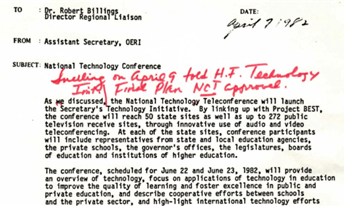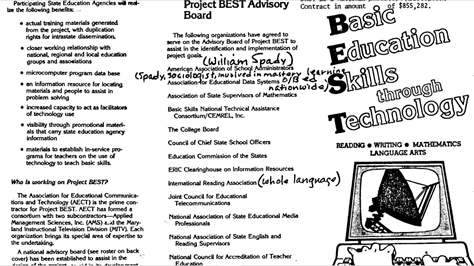For over forty years, coalitions of academics, governments, corporations, and world governance bodies have colluded to build a global ed-tech schooling system meant to shackle children to the transhumanist Fourth Industrial Revolution.
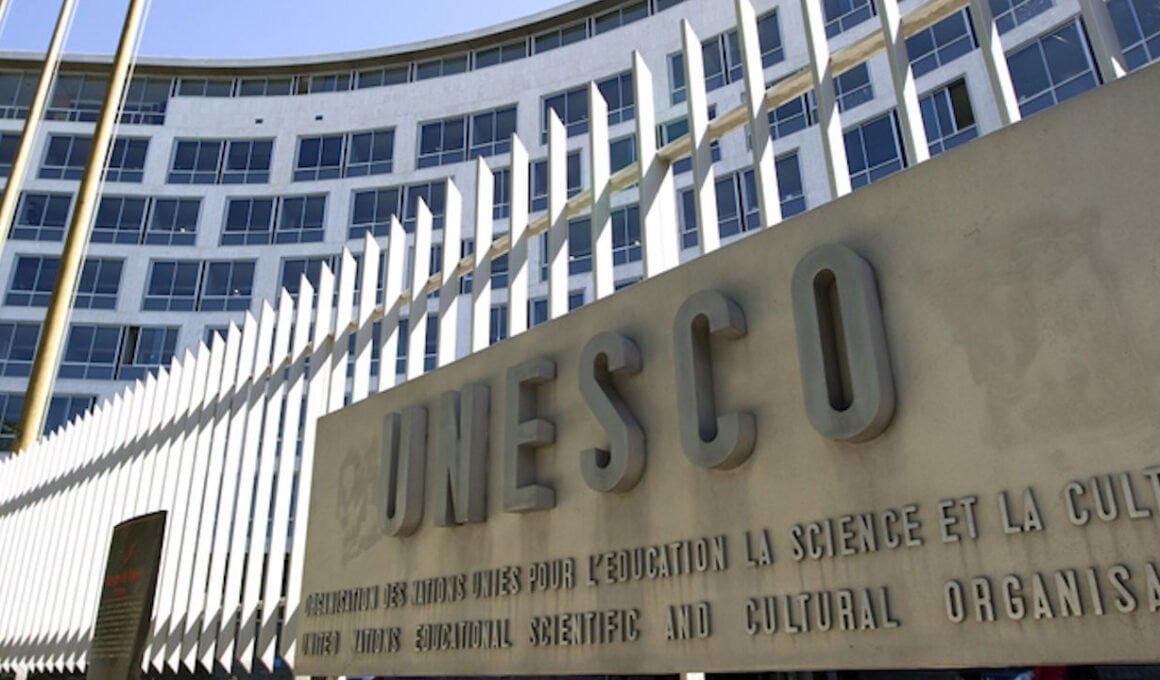
I recently visited former Senior Policy Advisor to the US Office of Educational Research and Improvement, Charlotte Thomson Iserbyt, who gave me access to her archive of files that she collected from the US Department of Education. After digging through a collection of files collated by Lawrence P. Grayson, who was the Advisor for Mathematics, Science and Technology at America’s National Institute of Education (NIE), I discovered that the Department of Ed’s Project BEST (Basic Education Skills through Technology), which Iserbyt leaked in 1981, was actually the USA’s domestic version of an international technology initiative spearheaded by the United Nations Educational Scientific and Cultural Organization (UNESCO).
While stationed at the NIE, Grayson was also the US Department of Ed’s liaison with UNESCO’s educational technology programs, including “Study 11: New Technologies in Education”, which he procured for Iserbyt in a bundle of interrelated memorandums and journals. Labeled as the “Grayson File,” this folder compiled the following documents:
- UNESCO Study 11 whitepapers that issue ed-tech directives to a region of 14 nation states grouping together communist, socialist, and capitalist countries;
- US Department of Ed memorandums which stipulate American collaboration with Study 11 and other UNESCO technology programs;
- Law journals that call for restructuring legal systems in order to globalize the computerized “information technology” (IT) revolution necessary to streamline international ed-tech markets;
- Academic journals containing ed-tech promotionals from Project BEST contractors and UNESCO Study 11 representatives published alongside commercial advertisements and order forms for Project BEST courseware and other e-learning products being sold by the very same companies, including Microsoft, Apple, and IBM, that are endorsed in the UNESCO Study 11 whitepapers.
This compilation of “Grayson File” documents shows that UNESCO’s Study 11 was carried out through international public-private partnerships between communist, socialist, and capitalist countries coordinating efforts between multinational telecommunications and computer corporations. Working in concert with academic institutions and national government agencies, Study 11 affiliates lobbied to restructure laws in order to globalize school systems through proto-internet technologies manufactured by Big Tech companies, such as Microsoft, IBM, and Apple, which are now steering the Fourth Industrial Revolution into a new political system of communitarian technocracy driven by a new economic system of “stakeholder capitalism” through “community-based” public-private partnerships that are managed by Big Data.
While this techno-fascist Fourth Industrial Revolution is being accelerated under the duress of coronavirus panic, global COVID lockdowns are sealing the deals for UNESCO Study 11 and Project BEST as schools around the entire world are forced to rely on the technocratic IT infrastructure that has been set up by Study 11 and Project BEST through their public-private partnerships with Microsoft, Apple, and IBM. These partnerships are now converting brick-and-mortar schoolhouses into virtual classrooms that digitally data-mine students through computer hardware devices, such as Apple iPads and Macbooks, which transmit video teleconferencing through software programs, including Microsoft Teams, supplemented by adaptive-learning courseware and other artificial-intelligence applications like IBM’s Watson Education.
Now that the IT infrastructure set up by Study 11 and Project BEST is firmly in place, globalist oligarchs at the World Economic Forum (WEF) are calling for a “Great Reset” to purportedly save the planet from COVID-19 by rushing into the Fourth Industrial Revolution with the help of WEF members, including Microsoft, Apple, and IBM, which are exploiting lockdowns in order to “reset” the global economy and “Reimagine Education” through ed-tech that is programmed to data-mine students’ “learning analytics” through “Social Credit” systems of “surveillance capitalism”. In the final equation, these “geospatial intelligence” systems will be hooked up to transhumanist neurotechnologies plugged into the “internet-of-things.” In the meantime, a UNESCO 2050 project is building on the IT infrastructure of Study 11 through the new UNESCO “Futures of Education” study, which advocates for a communitarian assimilation of AI ed-tech in order to “Reframe Humanism” to accelerate society’s evolution into the “more-than-human world” at the crux of the Fourth Industrial Revolution.
UNESCO “Study 11: New Technologies in Education” from Corporatism to Communism
The progression of UNESCO’s education technology programs from the 1970s through the 1980s demonstrates a gradual move toward synthesizing the centralized state governance of Eastern Bloc socialism and communism with the transnational corporatism of Western capitalism through the commercial globalization of ed-tech mass-produced by multinational companies that contract with national governments. While these globalist corporations have been selling their ed-tech products across national borders, their government partners have been moving to centralize their state education systems under the technocratic world governance directives of the United Nations, the Organization for Economic Cooperation and Development (OECD), the World Bank, and the World Economic Forum.
During the 1970s, UNESCO conducted a series of ed-tech studies that were published in whitepapers such as ED-77/WS/133: “Development of Educational Technology in Central and Eastern Europe: Division of Structures, Content, Methods and Techniques of Education.” In this 1977 report on “‘[l]ong distance’ education” through “audio-visual” technologies, such as “school radio and school television,” UNESCO endorsed the authoritarian educational systems of “centralized” socialist countries, such as the former USSR.
According to UNESCO ED-77/WS/133, there is:
“an extremely favorable situation for central state measures designed to modernize education. The socialist state possesses the means necessary for education, for the widespread use of methodology based on solid technological foundations and of the media and means of educational technology. . . . [T]he socialist countries are also in a favourable position because of the fact that television, school television, radio and school radio are operated centrally.”
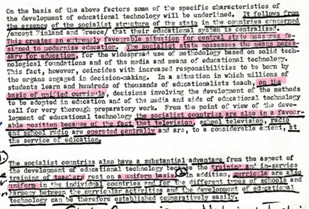
A few years later, between June 1980 and October 1982, UNESCO expanded the findings of this ED-77/WS/133 whitepaper and other ed-tech studies at a series of conferences, including the Third Conference of Ministers of Member States of the European Region of UNESCO and the Eighth Regional Conference of National Commissions of the European Region. As a result of these studies and conferences, the UNESCO National Commissions of the European Region’s Joint Studies in the Field of Education launched “Study 11: New Technologies in Education—Information and Communications Technologies and Their Impact on Education,” which orchestrated ed-tech research exchanges between Eastern Bloc communist and socialist regimes in exchange with Western capitalist countries dominated by multinational corporations, such as Microsoft, Apple, and IBM.
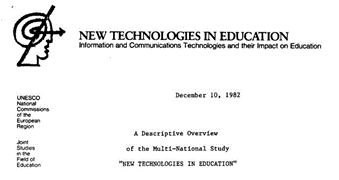
This “Multi-National” Study 11, which “[d]eveloped a comprehensive inquiry into the applications of technology in education,” coordinated efforts between “educational researchers, planners, decision-makers, and other interested parties” from the Participating National Commissions of UNESCO’s European Region, which included a mixture of communist, socialist, and capitalist nations: Austria, Belgium, Canada, Denmark, Finland, France, Hungary, Israel, Italy, Spain, Sweden, Ukrainian SSR, USSR, UK, and USA. The “other interested parties” of these UNESCO National Commissions included “educators, sociologists, psychologists, philosophers, technologists, and others suggested by the national coordinators,” such as Lawrence Grayson, who was the National Coordinator for the United States.
This UNESCO Joint Study of communist, socialist, and capitalist National Commissions was regionalized to cooperatively investigate the “current and planned applications of new technologies to education,” including ed-tech applications of “computers, videotex/teletext, interactive video (including videodisc), communications satellites, multichannel cable/fibre optics, teleconferencing (audio/video/computer), as well as new developments in video, audio, and audiographs.” More specifically, this UNESCO Study 11 investigated the comprehensive impacts of such evolving technologies on “learning theory, the quality of education, access to education, the role of the teacher, organization of education, financing of education, issues related to privacy and freedom, the interfaces between school and working life, school and home, education and state, education and society in general, and others.”
By regionalizing a single bloc of communist, socialist, and capitalist states under an advisory panel of cognitive scientists and technocrats, UNESCO Study 11 aimed not just to “upgrade” schools with hi-tech computers, but to dialectically integrate communist and socialist systems of educational statecraft with capitalist ed-tech markets. This communo-fascist synthesis would radically alter student privacy and educational freedom through global transformations of school governance and finance managed by computerized IT.
It is important to note here that, while UNESCO ED-77/WS/133 endorsed the centralized educational systems of authoritarian communist and socialist regimes, UNESCO Study 11 advocated the globalization of ed-tech through capitalist market economics dominated by multinational corporations, such as Microsoft, Apple, and IBM.
For example:
- In “Educational Technology in the Netherlands: A Review for UNESCO Joint Studies in the Field of Education, Study Group 11,” J. J. Beishuizen examined Didacom’s use of “BASIC standard [programming] with application software which can be used on the Apple . . . and on micro’s using Microsoft-BASIC.”
- Vittorio Midoro, “in collaboration with the Working Group of the Italian Commission of UNESCO,” published “New Technologies in Education: An Italian Report,” which studied the use of Apple IIE “installed in Italian schools.”
- Another Study 11 whitepaper entitled “New Technologies in Education in Canada: Issues and Concerns,” which was produced by UNESCO’s Canadian National Coordinator, Ignacy Waniewicz, received funding from IBM Canada Ltd. to explore “videodiscs [that] show novices how to use an IBM personal computer and explain some key programs.”
In sum, UNESCO Study 11 commissioned a coalition of communist, socialist, and capitalist nations to cooperate in their efforts to proliferate computerized ed-tech, such as “videotex/teletext” and “teleconferencing” software that is now a booming industry across the globe under the worldwide COVID lockdown being pushed by the WEF’s Great Reset. This global “reset” is calling for a new world economic system of communitarian “stakeholder capitalism” through techno-fascist public-private partnerships that enforce government lockdowns while mandating virtual “distance learning” through commercial e-learning technologies that are manufactured by WEF members, including Microsoft, Apple, and IBM. Their objective is to digitally data-mine students’ psychometrics for the purposes of Social Credit surveillance in the bourgeoning Fourth Industrial Revolution.
How Project BEST, UNESCO, and the OECD Paved the Way for the Fourth Industrial Revolution
In the United States, the ed-tech prospects of UNESCO’s Study 11 were piloted through Project BEST, which Secretary of Education T. H. Bell set up to corporatize the American education system through public-private partnerships that implement operant psychological conditioning through computerized “teaching machines” designed to program students for workforce training. Bell’s Assistant Secretary, Donald J. Senese, oversaw coordination between the “Regional Education Laboratories” of the USA’s domestic ed-tech pilot, Project BEST, aligned with the international ed-tech plans of UNESCO’s Study 11 along with the Centre for Educational Research and Innovation (CERI) of the Organization for Economic Cooperation and Development.
A March 18, 1982 Department of Ed memorandum titled “International Study of Educational Technology” reports that Senese selected Grayson to be the US Director of UNESCO Study 11 in order to jockey America’s position at the head of the United Nations multinational ed-tech project. In addition, Senese, who was a CERI Governing Board member, wrote an article in the January 1985 edition of the Technological Horizons in Education Journal: Computers in Education Worldwide, which states that Arthur Melmed of the US Department of Ed’s OERI was appointed to the “planning bureau” of CERI. Senese also assigned the Department of Ed’s Director of Regional Liaison, Robert Billings, to head the task of orchestrating collaboration between “state coordinators” in charge of disseminating Project BEST’s ed-tech initiatives. In brief, the Regional Liaison for Project BEST, the planning bureau of the OECD’s CERI, and the US National Coordinator of UNESCO Study 11 were all selected to report directly to Assistant Secretary Senese, who thereby oversaw coordination of Project BEST under the educational technology directives of UNESCO and the OECD.
Senese’s T.H.E. Journal article entitled “International Conference Examines Technology in Education” summarizes “500 pages of documentation” from the OECD’s CERI conference, which analyzed the “use of modern information technology in education,” including “the cognitive demands and consequences of the new technology on learning processes in formal education.” Senese also wrote that the conference’s fifth “working group” investigated “the production and exchange of software and courseware for a multimedia educational environment. Its principal recommendation was that OECD act to assist the development and establishment of international standards for the exchange of courseware authoring systems analogous to the standards that exist for machine tools or for certain computer programming languages.” At the same time, UNESCO was beta-testing “best practices” in educational technologies through Study 11, which was overseen by Grayson, who reported back to Senese in the USA.
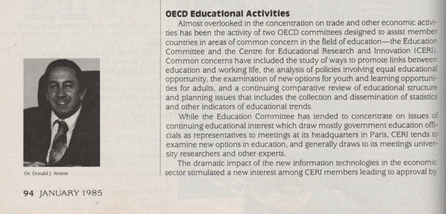
As the American go-between for the OECD and UNESCO, Assistant Secretary Senese would assign Director of Regional Liaison, Robert Billings, to coordinate US Project BEST with international standards and “best practices,” such as those recommended by Study 11 and CERI. According to an internal US Department of Ed memorandum sent from Senese to Billings, Project BEST was advanced through Secretary Bell’s Technology Initiative launched at the 1982 National Technology Teleconference, which called for “international technology” collaboration.
In the Assistant Secretary’s memo to Billings sent on April 7, 1982, Senese stated that “[t]he conference . . . will provide an overview of technology, focus on applications of technology in education . . . and describe cooperative efforts between schools and the private sector, and high-light international technology efforts in education.” This same memorandum tasked Regional Liaison Billings to take “[t]he first step in the participation of the regional directors of dissemination [through] training activities at the University of Maryland, May 10-13, 1982 conducted by Project BEST. . . . The training will . . . provide an opportunity to meet the state coordinators for Project BEST in their region [sic]. While state coordinators will coordinate state-wide technology activities for Project BEST, the regional office must play a key role in facilitating cooperation among the states.” To put it all together, this memorandum from Senese appointed Billings to regionally coordinate “international technology” initiatives across the US through interstate public-private planning of Project BEST in accordance with the call to action broadcasted at Secretary’s Bell’s National Technology Conference.
Just eight days after issuing this memo to Regional Liaison Billings, Assistant Secretary Sense sent Secretary Bell an “Executive Correspondence Memorandum” that documents how Bell’s “National Conference on Technology and Education,” which was funded through Project BEST’s contract with the Association for Educational Communications and Technology (AECT), was collaborating with the Organization for Economic Cooperation and Development.
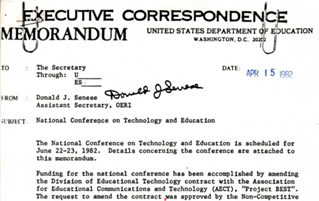
In sum, these memos document that Senese, who received reports from Melmed at CERI and Grayson at UNESCO, directed Billings to coordinate America’s regional dissemination of Project BEST in coordination with international standards and best practices in accordance with Bell’s Technology Initiative launched through the National Technology Conference. In other words, Senese, in concert with Melmed, Grayson, and Billings, coordinated UNESCO and OECD international standardization of ed-tech through the propagation of Project BEST technologies across the USA’s 10 Regional Educational Laboratories, including the Northwest Regional Educational Laboratory (NWREL), Shirley McCune’s Midcontinental Regional Educational Laboratory (MCREL), and William G. Spady’s Far West Regional Laboratory for Educational Research and Development (FWRL), which served as launchpads for disseminating BEST ed-tech to schools throughout the United States.
How UNESCO and Project BEST Set the Stage for Globalist Virtual Charter School Corporations
Not only did the Department of Education’s 10 Regional Laboratories orchestrate Project BEST cooperation across the 50 states, but the Regional Labs also facilitated international coordination with UNESCO and its member countries. These inter-regional networks laid the technological building blocks for globalist virtual charter schools, such as K12 Inc. and Bridge International Academies, which paved the way for the “distance learning” industry that now is replacing brick-and-mortar schools as COVID lockdowns force the planet to learn online through data-mining ed-tech.
Even prior to the rollout of Project BEST, the Northwest Regional Education Laboratory was the US representative to the UNESCO Institute for Education’s 1978 “School Textbooks for Lifelong Learning” study, which reports that the replacement of textbooks with audiovisual technologies, such as “films, radio and television broadcasts, language laboratories, etc.,” would free students from “the dictatorship of the textbook.” This document shows that, even before Project BEST and Study 11, UNESCO and NWREL were already working together to coordinate a global shift toward computerized ed-tech by transitioning from traditional print textbooks to multimedia telecommunications technologies.
Later, in 1982, during the rollout of Project BEST, NWREL set up the Resources in Computer Education (RICE) database, which was made searchable through the international School Practices Information Network (SPIN) operated by BRS Inc. According to a 1982 NWREL news release titled “New Source of Information about Computer Education Resources Goes Online,” the RICE-SPIN data system partnered with the International Council for Computers in Education. Additionally, a SPIN advertisement from Scott, Foresman and Company’s Electronic Publishing Division boasts that “SPIN provides access to over 1,000,000 educational resources and an international network of educators, all accessible with a microcomputer and telephone.”

To put it all together, as Project BEST was being rolled out, NWREL’s public-private partnership with Scott, Foresman and Company was setting up an international proto-internet network that laid the groundwork for a global e-learning system aligned with the ed-tech goals of Study 11, which was commissioned by UNESCO shortly after UNESCO teamed up with NWREL to pave the way for computerized schooling by shifting from print textbooks to audiovisual telecommunications.
NWREL’s international SPIN internet, which dovetailed with Project BEST, would effectively serve as a model for the “High Success Schools” program, which was spearheaded by William G. Spady, the Director of the Far West Regional Laboratory for Educational Research and Development. In a 1995 article titled “Welcome to High Success Schools,” FWRL Director Spady narrates a case study of his “high-success” international online-learning model:
“Students at Jefferson Senior High are holding a teleconference in the media center with a class of students in Russia. They have been working all year on a project to investigate the effects of rapid social and economic change on their communities and how technology impacts those changes. Their collaborative report will be presented to scientists and technology experts around the world who have been assisting their research efforts through the Internet and have agreed to evaluate their research.”
Notice here that FWRL Director Spady showcases how his “high-success” internet-learning program highlights international online exchanges between capitalist American students and communist Russian students collaborating with “world experts” in accordance with UNESCO Study 11’s regional ed-tech exchanges between communist, socialist, and capitalist nations.
Kickstarted by NWREL and FWRL Director Spady, these High Success and RICE-SPIN computer networks were prototypical online-learning startups that planted the seeds for other globalist internet-learning platforms grown out of Study 11 and Project BEST. These growing online “distance learning” platforms include virtual charter school corporations, such as Bridge International Academies, which was funded by the World Bank, and K12 Inc., which enrolls students through its K12 International Academy in affiliation with the Association for the Advancement of International Education, the Association of International Schools in Africa, the Central and Eastern European Schools Association, the East Asia Regional Council of Overseas Schools, and the European Council of International Schools. It should be noted that K12 Inc., which is one of the largest online charter schools in the United States, was set up by Secretary of Education William “Bill” Bennett, who oversaw the educational provisions of President Ronald Reagan’s General Exchange Agreements with the Soviet Union after Bennett took over Project BEST as the successor to Secretary T. H. Bell.
Roughly forty years later, the globalist virtual charter school industry resulting from BEST sub-projects, such as the internet e-learning pilots of NWREL’s RICE-SPIN network and Spady’s High Success Schools, has provided the online-learning infrastructure to “Reset” and “Reimagine” education for the Fourth Industrial Revolution. Expanding on these virtual charter school markets, the techno-oligarchs of the Fourth Industrial Reset are executing an ed-tech takeover that is exploiting government lockdowns to force all schools into computerized “distance learning” facilitated by Big Tech corporations, including WEF members like Microsoft, Apple, and IBM, in order to data-mine students’ “learning analytics” through AI surveillance algorithms.
Academic Echo Chambers and Peer-Regurgitated Propaganda
While Project BEST was building the international internet infrastructure for virtual learning platforms like K12 Inc. and BIA, multinational technology corporations, such as Microsoft, Apple, and IBM, were jockeying for positions in the global market to facilitate the hardware and software needed to operate the online courseware for the national education systems participating in UNESCO Study 11. At the same time, the globalist academic establishment was promoting school integration of courseware from these very same Big Tech corporations by advertising their “computer-assisted learning” products in the pages of scholarly journals alongside ads for other ed-tech developers contracting with Project BEST, such as Scott, Foresman and Company and the Association for Educational Communications and Technology (AECT). Simultaneously, these same academic journals printed articles publicizing the ed-tech research of the OECD and UNESCO Study 11, which was advocating the use of commercial ed-tech products manufactured by the exact same Big Tech companies, including Microsoft, Apple, and IBM.
In brief, these journals document how Project BEST was part of an orchestrated effort between academia, national governments, multinational corporations, and the world governance bodies of UNESCO and the OECD acting in concert to advance global progress toward the technocratic Fourth Industrial Revolution. Today, this techno-fascist revolution is now shifting into high gear as COVID lockdowns are being exploited by the very same Big Tech corporations, including Microsoft, IBM, and Apple, which were promoted by UNESCO Study 11 before they became agents of the World Economic Forum’s Great Reset.
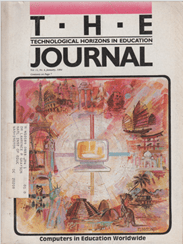
For example, in the January 1984 edition of Technological Horizons in Education Journal, there are advertisements for IBM PC’s Edu-Mod designed by Bell & Howell Co.; Orion Training System’s Introduction to BASIC Programming courseware for Apple II+ or Apple IIe; and Telos Software’s TeloSchool for Apple II+ or Apple IIe. Likewise, in the January 1983 edition of T.H.E. Journal, there are advertisements for LOGO programming software on Apple computers; muMATH/muSIMP Advanced Math Package courseware for IBM Personal Computer; and Microsoft BASIC programming manuals. At the same time, this 1983 issuecontains an ad for reading, science, and mathematics courseware from the Electronic Publishing Division of Scott, Foresman and Company, which operated the SPIN internet that facilitated the RICE database through the US NWREL where Project BEST startups were piloted. Moreover, in this very same 1983 issue, T.H.E. Journal also published an article titled “Computers in Swedish Schools: Experience, Research, and Problems” by Anita Köllerbaur, Sweden’s National Coordinator for UNESCO Study 11 under International Coordinator Lawrence Grayson, who was appointed by Project BEST Coordinator, Assistant Secretary of Education Senese.
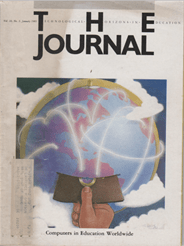
In sum, both the 1983 and 1984 issues of T.H.E. Journal are filled with advertisements for ed-tech products from WEF-partnered corporations, including Microsoft, IBM, and Apple, which were likewise endorsed by UNESCO Study 11. Simultaneously, the 1983 issue published a whitepaper on “computer-assisted learning” technology from a UNESCO Study 11 representative while advertising courseware products from computer-tech companies, such as Scott, Foresman and Company, linked to Project BEST, which was America’s domestic version of UNESCO Study 11.
Similarly, in the January 1985 edition of T.H.E. Journal, there is an advertisement for a book published by the Association for Educational Communications and Technology, which was awarded two US Department of Education contracts totaling a $1,189,715 payout to propagate ed-tech through Project BEST. This T.H.E. Journal ad, which appears on page 90 of the 1985 issue, suggests that an AECT book, entitled Software Quality & Copyright: Issues in Computer-Assisted Instruction, will provide the answer to the question: “[h]ow can educators select the best software programs?”
On page 91, right across from the AECT ad, is an article titled “Phone Tele-Teaching Brings Classes to Students at Home,” which is followed by another article, “Projector Brings Interactive Video to Computer Classes,” on page 92. In this very same 1985 issue, T.H.E. Journal published an article entitled “International Conference Examines Technology in Education” by Project BEST Coordinator Donald Senese, who wrote this article as a public relations report advocating the OECD’s push for internationally standardized ed-tech.
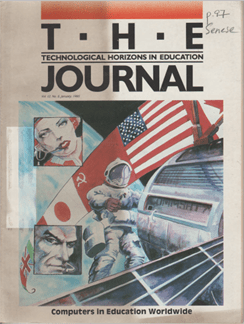
To simplify, this 1985 issue of T.H.E. Journal published an OECD report calling for international ed-tech standards promoted by Project BEST Coordinator Senese while simultaneously advertising the courseware recommendations of the AECT, which was the primary contractor for Project BEST. This AECT ad appeared alongside articles for virtual homeschooling through teleconferencing technologies resembling the current line of video-conferencing software, such as Microsoft Teams and Google Classroom, which can be transmitted through Apple computers that can be upgraded with the adaptive-learning artificial intelligence of IBM’s Watson Education.
Altogether, Grayson’s sample of T.H.E. Journals illustrates how academic publications were promoting ed-tech whitepapers from UNESCO Study 11 and the OECD while advertising Project BEST technologies, including courseware products developed by current WEF members, such as Microsoft, Apple, and IBM, which are now spearheading the rush into a technocratic Fourth Industrial Revolution geared to track and trace students’ learning algorithms into psychological profiles that can be data-mined for “predictive analytics” in a communitarian Social Credit system of “geospatial intelligence.”
Legislating for the Future Trends and Megatrends of the Fourth Industrial Revolution
While the academic establishment was pushing commercial ed-tech products through its promotions of both UNESCO Study 11 and Project BEST publicized in scholarly journals, lobbyists were petitioning state and federal bar associations to reform legal systems in order to standardize regulations for international technology exchanges that would streamline IT integration for business operations and government administration across the globe in the coming Fourth Industrial Revolution.
In addition to the T.H.E. Journals collated in the Grayson File given to Iserbyt, there is also a June 1984 issue of the American Bar Association Journal, which contains an article written by John Naisbitt, who worked as an IBM executive before he was appointed Assistant Commissioner of Education in the US Department of Health, Education, and Welfare under President John F. Kennedy. Author of the 1982 book, Megatrends: Ten New Directions Transforming Our Lives, Naisbitt wrote a 1984 ABA Journal article entitled “Megatrends for Lawyers and Clients,” which lauds how “[t]he largest and most significant shift has been the transformation of America over the past 30 years from an industrial to an information-based society.” Naisbitt adds that, “[h]and in hand with this is our shift away from a national toward a global economy.” Forecasting the Fourth Industrial Revolution, Naisbitt proclaims that “[w]hat is called for is nothing less than all of us—including lawyers—to reconceptualize our roles in a new society.”
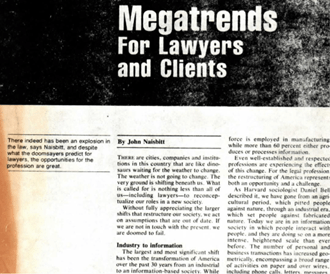
Simply put, Naisbitt’s “Megatrends” article was a call to action for lawyers to become “change agents” who push for legal system reforms that would greenlight America’s evolution from a nationalistic manufacturing economy into a global IT economy for the Fourth Industrial Revolution.
Naisbitt’s call to action was followed by Shirley McCune, who was the director of the US Department of Ed’s Midcontinental Regional Education Laboratory (McREL), which piloted Project BEST’s ed-tech programs throughout the states of Missouri, Kansas, Nebraska, Colorado, North Dakota, South Dakota, and Wyoming. In 1983, the US Department of Education funded two McREL projects to be directed by McCune: “Framing a Future for Education” in Kansas and “Strategic Planning and Furthering Excellence in Millard Public Schools” in Nebraska, both of which were guided by the program directives of the Naisbitt Group.
Later, at a 1989 National Governors Association conference in Wichita, Kansas, McCune professed that
“[w]hat we’re into is the total restructuring of society. What is happening in America today and what is happening in Kansas and the Great Plains is not simply a chance situation in the usual winds of change. What it amounts to is a total transformation of society. . . . Our total society is in a crisis of restructuring and you can’t get away from it. You can’t go into rural areas, you can’t go into churches, you can’t go into government or into business and hide from the fact that what we are facing is the total restructuring of our society.”
That same year, in a Washington Bremerton Sun article titled “Schools of the Future,” McCune called for revamping schools into futuristic “community learning centers” that would emphasize “integrating technology with curriculum” in order to psychologically condition students for “lifelong learning” from cradle to career.
Similarly, William Spady, who ran Project BEST through FWRL, cited Naisbitt’s Future Trends during his 1990 speech titled “Ensuring the Success of All Students Today for Tomorrow’s Changing World,” which he presented to the US Department of Defense:
“[w]hen addressing the issue of Exit Outcome development in one of our Illinois high school districts during the Spring, I too was forced to take a look at the ‘realities’ that seem to surround us and that have the potential for shaping the character of the future in which we and our children will live. At first blush, ten somewhat interrelated trends seemed clear to me, . . . some of which resemble trends identified by John Naisbitt and his Future Trends colleagues.”
In other words, Spady forecasted that the future of schooling would need to evolve in accordance with the “future trends” of the Fourth Industrial Revolution as predicted by Naisbitt.
While Spady and McCune regionally launched Project BEST technologies at FWRL and McREL, which is now McREL International, under the provisions of Naisbitt’s “future trends,” Project BEST Coordinator Senese was meeting with globalist technocrats at the OECD/CERI ed-tech conference where they examined how “to reduce the legal and technical barriers that inhibit the transportability of software products across national boundaries.” Then, four years after Spady’s Department of Defense speech, the Bill Clinton administration amended the Elementary and Secondary Education Act with the addition of the 1994 federal Charter Schools Program, which opened avenues for virtual charter schools that implement online learning through computer technologies.
Building on precedents set by the federal Charter Schools Program, the American Legislative Exchange Council (ALEC) drafted the Virtual Public Schools Act, which was published in 2005 as a “template” bill that was disseminated across the United States to various state and federal legislators who copied and pasted it into real bills which would create laws authorizing the expansion of virtual charter schools and “community schools” that utilize computer technologies to teach “students via the Internet in a virtual or remote setting.”
Fifteen years later, former President Donald Trump’s US Secretary of Education, Betsy DeVos, who financed K12 Inc. charter schools and Neurocore biofeedback wearables for ADHD students, issued new federal rules for “Distance Learning and Innovation” (85 FR 18638), which deregulated the classroom “use of artificial intelligence and other adaptive learning” ed-tech that is still being funded by billions of dollars of stimulus money from the Coronavirus Aid, Relief and Economic Security (CARES) Act. It should be noted that 85 FR 18638’s “Accreditation and Innovation negotiating committee” included a Government Relations representative from IBM, which was promoted by UNESCO Study 11 and the Project BEST promotionals of T.H.E. Journal before IBM joined the World Economic Forum’s Great Reset for the Fourth Industrial Revolution.
UNESCO’s Transhumanist “Futures of Education” 2050
Now, in the midst of the COVID lockdown reset, UNESCO is convening an International Commission to oversee the “Futures of Education: Learning to Become” project, which is “a global initiative to reimagine how knowledge and learning can shape the future of humanity and the planet” through “digital, biotechnology and neuroscience developments” that will drive the Fourth Industrial Revolution. This UNESCO 2050 initiative takes Study 11 to the next level as it charts a “more-than-human,” or transhuman, future in which homo sapiens will “evolve” with a global IT economy integrated with biotech and neurotech systems of Big Data managed by an international “commons” of “stakeholder” corporations. Looking to this 2050 future envisioned by UNESCO, global “stakeholder” companies, through communitarian public-private partnerships, are on a trajectory to blanket the planet with posthuman AI ed-tech in order to “Reframe Humanism” by data-mining students’ biopsychosocial algorithms for the purposes of “unleash[ing] an engineering of human beings previously inconceivable,” according to UNESCO.
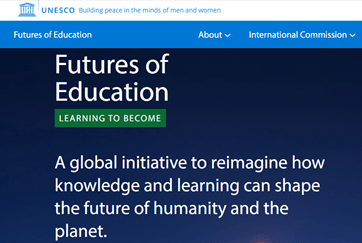
In March 2021, the UNESCO Commission on the Futures of Education published a “Progress Update,” which predicts that “[t]echnological advancements, particularly around artificial intelligence and automation, will create new jobs and will complement and augment the capabilities of workers in existing jobs. . . . Traditional pathways connecting education to work may have to be reinvented.” More specifically, this UNESCO forecast for “the economic world of 2050” foresees the “death of the school,” which “will be replaced by an infinity of devices and approaches—strongly supported by digital technology and artificial intelligence—all of which point in the direction of a ‘hyper‐personalization’ of learning. In such scenarios, schools are seen as obsolete institutions. Teachers become expendable professionals, who could easily be replaced by other forms of monitoring and supervision.”
To be sure, UNESCO cautions such a future scenario: “the premises underlying this vision, fueled by the unprecedented expansion of the global education market in which the EdTech industry leads the way, has been leading us down a dangerous path. It destroys social institutions without providing proven alternatives. And it must be resisted in the name of a regenerative education.” Nevertheless, despite this Rogerian consideration of the “dangerous path” being carved out by AI ed-tech, UNESCO’s call to “resistance” does not urge humanity to fully depart from this destructive path toward a posthuman technocracy. Instead, this UNESCO 2050 whitepaper resolves to double down on the “regenerative” promises of AI ed-tech in hopes that it can be distributed “equitably” through “a new ‘social contract for education’” managed by a “commons” of “public and private” partnerships with corporate “stakeholders” in an “international community.”
Stated differently, UNESCO’s Futures of Education greenlights a global continuation down the dystopic path toward a Social Credit system of automated ed-tech surveillance so long as the AI algorithms are “equitably” meted out by the new brand of communitarian “stakeholder capitalism” that is being hyped by the World Economic Forum’s Great Reset for the Fourth Industrial Revolution. Indeed, UNESCO’s International Commission declares that “[t]he diversification of actors [including ed-tech companies] in the education sector should be welcomed as long as it enhances the capacities of public authorities and communities to harness the regenerative power of education to address the severe challenges facing humanity.” In other words, UNESCO bargains that the technocratic path toward AI schooling should be pursued as long as ed-tech corporations are fascistically merged with “public authorities” and other community stakeholders for the purposes of “regenerating” humanity.
Don’t be fooled by UNESCO’s rhetoric of communitarian “equity.” At the bottom line, this UNESCO 2050 report is capitulating to the transhumanist merger of humans and computers through a corporate-fascist system of AI ed-tech. In a section e





